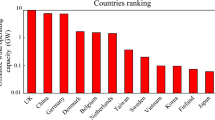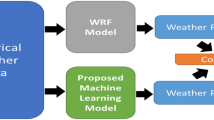Abstract
Drought is a natural disaster that profoundly impacts all parts of the environment. Drought forecasting could provide technical support for drought risk prevention. This paper explored and compared the forecasting abilities of the autoregressive integrated moving average (ARIMA) in statistics, the wavelet neural network (WNN) and the support vector machine (SVM) in machine learning for drought forecasting in the Sanjiang Plain, China. The models used in this paper are based on the standard precipitation evapotranspiration index (SPEI) on the 12-month timescale. The SPEI was calculated using precipitation and temperature data collected during the period 1979–2016 from seven meteorological stations in the study area. Then, the SPEI series were predicted with the ARIMA, WNN and SVM models separately. The coefficient of determination (R2), mean-squared error (MSE), Nash–Sutcliffe efficiency coefficient (NSE) and Kolmogorov–Smirnov (K–S) distance, which is a nonparametric measure, were used to evaluate the performance of all models. A comparison between the raw data and predictions illustrates that the R2 and NSE values of the WNN model were 0.837 and 0.831, respectively; those of the SVM model were 0.833 and 0.827, respectively; and those of the ARIMA model were both > 0.9. Moreover, the ARIMA model had smaller MSE and K–S distance values than those of the other two models. Further, analysis of variance showed that the ARIMA model exhibited an obvious advantage over the other two models when forecasting drought in the Sanjiang Plain, China. Therefore, the method used for drought forecasting depends not only on the object of the data series but also on the underlying concepts of the models or algorithms and is a choice that should be made with caution.











Similar content being viewed by others
References
Akaike, H. (1974). A new look at the statistical model identification. IEEE Transactions on Automatic Control,19(6), 716–723.
Barker, L. J., Hannaford, J., Chiverton, A., & Svensson, C. (2016). From meteorological to hydrological drought using standardised indicators. Hydrology and Earth System Sciences,20(6), 2483–2505.
Belayneh, A., Adamowski, J., Khalil, B., & Ozga-Zielinski, B. (2014). Long-term SPI drought forecasting in the Awash River Basin in Ethiopia using wavelet neural network and wavelet support vector regression models. Journal of Hydrology,508, 418–429.
Bierkens, M. F. P., Knotters, M., & Hoogland, T. (2001). Space–time modeling of water table depth using a regionalized time series model and the Kalman filter. Water Resources Research,37(5), 1277–1290.
Box, G. E. P., & Jenkins, G. M. (1976). Time series analysis, forecasting and control. Hoboken: Wiley.
Chevalier, R. F., Hoogenboom, G., McClendon, R. W., & Paz, J. A. (2011). Support vector regression with reduced training sets for air temperature prediction, a comparison with artificial neural networks. Neural Computing and Applications,20, 151–159.
Decoste, D., & Schölkopf, B. (2002). Training invariant support vector machines. Machine Learning,46, 161–190.
Djerbouai, S., & Souag-Gamane, D. (2016). Drought forecasting using neural networks, wavelet neural networks, and stochastic models, case of the Algerois Basin in north Algeria. Water Resources Management,30(7), 2445–2464.
Durbach, I., Merven, B., & Mccall, B. (2017). Expert elicitation of autocorrelated time series with application to e3 (energy-environment-economic) forecasting models. Environmental Modelling and Software,88, 93–105.
Easterling, D. R., Wallis, T. W. R., Lawrimore, J. H., & Heim, R. R., Jr. (2007). Effects of temperature and precipitation trends on US drought. Geophysical Research Letters,34(20), 396.
Emmanouil, A. V. (2016). Modeling of temporal groundwater level variations based on a Kalman filter adaptation algorithm with exogenous inputs. Journal of Hydroinformatics,19(2), 191–206.
Ghosh, S., Panigrahi, K., & Parhi, D. (2016). Performance comparison of novel WNN approach with RBFNN in navigation of autonomous mobile robotic agent. Serbian Journal of Electrical Engineering,13(2), 239–263.
Giustolisi, O., & Laucelli, D. (2005). Increasing generalisation of input–output artificial neural networks in rainfall–runoff modelling. Hydrological Sciences Journal,50(3), 439–457.
Giustolisi, O., & Savic, D. A. (2006). A symbolic data-driven technique based on evolutionary polynomial regression. Journal of Hydroinformatics,8(3), 207–222.
Guo, H., Bao, A., Liu, T., Jiapaer, G., Ndayisaba, F., Jiang, L., et al. (2018). Spatial and temporal characteristics of droughts in Central Asia during 1966–2015. Science of the Total Environment,624, 1523–1538.
Hassani, H., & Silva, E. S. (2015). A Kolmogorov–Smirnov based test for comparing the predictive accuracy of two sets of forecasts. Econometrics,3(3), 590–609.
Hu, W., Yan, L., Liu, K., & Wang, H. (2016). A short-term traffic flow forecasting method based on the hybrid PSO-SVR. Neural Processing Letters,43(1), 155–172.
Jin, X., Du, J., Liu, H., Wang, Z., & Song, K. (2016). Remote estimation of soil organic matter content in the Sanjiang Plain, Northest China: The optimal band algorithm versus the GRA-ANN model. Agricultural and Forest Meteorology,218–219, 250–260.
Li, X., He, B., Quan, X., Liao, Z., & Bai, X. (2015). Use of the standardized precipitation evapotranspiration index (SPEI) to characterize the drying trend in southwest China from 1982–2012. Remote Sensing,7(8), 10917–10937.
Liu, H., Tian, H. Q., & Li, Y. F. (2012). Comparison of two new ARIMA-ANN and ARIMA-Kalman hybrid methods for wind speed prediction. Applied Energy,98, 415–424.
Maier, H. R., Jain, A., Dandy, G. C., & Sudheer, K. P. (2010). Methods used for development of neural networks for the prediction of water resource variables in river systems, current status and future directions. Environmental Modelling and Software,25(8), 891–909.
Makridakis, S., Spiliotis, E., & Assimakopoulos, V. (2018). Statistical and Machine learning forecasting methods: Concerns and ways forward. PLoS ONE,13(3), e0194889.
Mishra, A. K., Desai, V. R., & Singh, V. P. (2007). Drought forecasting using a hybrid stochastic and neural network model. Journal of Hydrologic Engineering,12(6), 626–638.
Mokhtarzad, M., Eskandari, F., Vanjani, N. J., & Arabasadi, A. (2017). Drought forecasting by ANN, ANFIS, and SVM and comparison of the models. Environmental Earth Sciences,76, 729.
Ndehedehe, C. E., Awange, J. L., Corner, R. J., Kuhn, M., & Okwuashi, O. (2016). On the potentials of multiple climate variables in assessing the spatio-temporal characteristics of hydrological droughts over the Volta Basin. Science of the Total Environment,557–558, 819–837.
Pandey, P. K., Tripura, H., & Pandey, V. (2019). Improving Prediction accuracy of rainfall time series by hybrid SARIMA–GARCH modelling. Natural Resources Research,28(3), 1125–1138.
Rhee, J., & Im, J. (2017). Meteorological drought forecasting for ungauged areas based on machine learning: Using long-range climate forecast and remote sensing data. Agricultural and Forest Meteorology,237–238, 105–122.
Roundy, J. K., Ferguson, C. R., & Wood, E. F. (2014). Impact of land-atmospheric coupling in CFSV2 on drought prediction. Climate Dynamics,43, 421–434.
Shin, K. S., Lee, T. S., & Kim, H. J. (2006). An application of support vector machines in bankruptcy prediction model. Expert Systems with Applications,28(1), 127–135.
Sujay, R. N., & Paresh, C. D. (2014). Support vector machine applications in the field of hydrology: A review. Applied Soft Computing Journal,19, 372–386.
Sun, C., & Ma, Y. (2015). Effects of non-linear temperature and precipitation trends on Loess Plateau droughts. Quaternary International,372, 175–179.
Tiwari, M. K., & Chatterjee, C. (2011). A new wavelet-bootstrap-ANN hybrid model for daily discharge forecasting. Journal of Hydroinformatics,13(3), 500–519.
Torrence, C., & Compo, G. P. (1998). A practical guide to wavelet analysis. Bulletin of the American Meteorological Society,79(1), 61–78.
Vicente-Serrano, S. M., Beguería, S., & Lópezmoreno, J. I. (2010). A multi-scalar drought index sensitive to global warming: The standardized precipitation evapotranspiration index. Journal of Climate,23(7), 1696–1718.
Witten, I. H., Frank, E., & Hall, M. A. (2011). Data mining: Practical machine learning tools and techniques (3rd ed.). San Francisco: Margan Kaufmann.
Xiao, M., Zhang, Q., Singh, V. P., & Liu, L. (2016). Transitional properties of droughts and related impacts of climate indices in the Pearl River basin, China. Journal of Hydrology,534, 397–406.
Yao, N., Li, Y., Lei, T., & Peng, L. (2017). Drought evolution, severity and trends in mainland China over 1961–2013. Science of the Total Environment,616–617, 73–89.
Zhang, Y., Li, W., Chen, Q., Pu, X., & Xiang, L. (2017). Multi-models for SPI drought forecasting in the north of Haihe River Basin, China. Stochastic Environmental Research and Risk Assessment,31(10), 2471–2481.
Zhang, T., & Lin, X. (2016). Assessing future drought impacts on yields based on historical irrigation reaction to drought for four major crops in Kansas. Science of the Total Environment,550, 851–860.
Zhao, J., Xu, J., Xie, X., & Lu, H. (2016). Drought monitoring based on TIGGE and distributed hydrological model in Huaihe River Basin, China. Science of the Total Environment,553, 358–365.
Acknowledgments
This research was supported by the National Key Research and Development Program of China (2017YFC0406002) and the Clean Development Mechanism (CDM) Fund Grant Program of China (2014108). The authors thank the anonymous reviewers for their valuable comments and constructive suggestions for improving the paper.
Author information
Authors and Affiliations
Corresponding author
Rights and permissions
About this article
Cite this article
Zhang, Y., Yang, H., Cui, H. et al. Comparison of the Ability of ARIMA, WNN and SVM Models for Drought Forecasting in the Sanjiang Plain, China. Nat Resour Res 29, 1447–1464 (2020). https://doi.org/10.1007/s11053-019-09512-6
Received:
Accepted:
Published:
Issue Date:
DOI: https://doi.org/10.1007/s11053-019-09512-6




